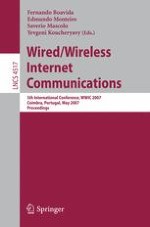WWIC 2007 was organized by the University of Coimbra, Portugal, and it was the fifth event of a series of International Conferences on Wired/Wireless Internet Communications, addressing research topics such as the design and evaluation of protocols, the dynamics of the integration, the performance trade-offs, the need for new performance metrics, and cross-layer interactions. Previous events were held in Berne (Switzerland) in 2006, Xanthi (Greece) in 2005, Frankfurt (Germany) in 2004, and Las Vegas (USA) in 2002. As in 2005 and 2006, WWIC was selected as the official conference by COST Action 290 (Wi-QoST–Traffic and QoS Management in Wireless Multimedia Networks). WWIC 2007 brought together active and proficient members of the networking community, from both academia and industry, thus contributing to scientific, strategic, and practical advances in the broad and fast-evolving field of wired/wireless Internet communications. The WWIC 2007 call for papers attracted 257 submissions from 36 different countries in Asia, Australia, Europe, North America, and South America. These were subject to thorough review work by the Program Committee members and additional reviewers. The selection process was finalized in a Technical Program Committee meeting held in Malaga, Spain, on February 15, 2007.
